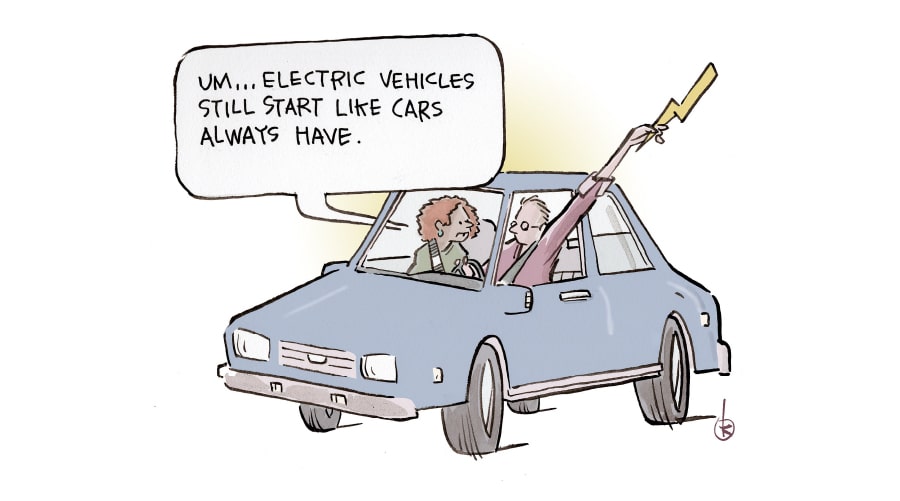You’ve signed the Going Electric Pledge, or perhaps you were inspired by an EV-driving friend or colleague, but in any case, you’ve decided you want to drive electric. Now what?! With more and more people reaping the benefits of driving electric (lower maintenance costs, no more gas, zero tailpipe pollution, great acceleration), it’s no wonder that 38% of people recently polled by Consumer Reports said they would at least seriously consider getting an EV. Over 100,000 Americans have pledged to make their next car electric. If you’re ready to go electric today, check out these useful next steps:
1. Talk with an existing EV owner
Nothing beats advice from someone that already made the switch. In fact friends and family are one of the top sources of information for those considering an EV. Reach out to someone you already know who drives an EV and ask how they like it and what you need to take into consideration. Having a hard time finding someone? Reach out to Generation180 and we can likely connect you with someone in your area. Need proof that peer influence makes a difference check out our latest report on accelerating EV adoption.
2. Consider your driving habits
Do you live in a suburban, urban or rural area? Do you typically take shorter or longer trips? (the average daily commute is only around 30 miles by the way). These questions will help you determine the range you need for your EV. An older EV model (typically with a smaller battery capacity) may have less range than newer models with extended range options. The good news is, no matter which model you choose, there will likely be an EV to fit your needs given that in 2023, the median range for all EVs was 270 miles! More than enough for your daily trips.
3. Convenient places to charge up
Charging infrastructure is increasingly available across the country, in shopping centers and other areas where people tend to drive and leave their cars for long periods of time. More workplaces are even jumping on the charging infrastructure wagon to encourage employees who may want to return to the office. In addition, the Federal Government recently launched a $5 billion dollar program over the next five years called the National Electric Vehicle Infrastructure (NEVI) program to install public fast chargers across the country no more than 50 miles apart.
Many EVs can charge using a common 110 volt electrical outlet (the same type of outlet you’d plug your toaster into), but it will take longer to charge the battery. You can have a Level 2 charger installed at home for even faster charge times – it runs on the same power as your dryer – but requires an electrician to install (many dealers can help you find an experienced local electrician to help). This faster charging option costs more to install, but gives greater certainty you’ll get into a car with a fully charged battery.
If you live in an apartment, HOA, or condo, there are options for you too. Check out our Multi-Unit Dwelling Charging Toolkit for more information.
4. Check your insurance coverage
With any large, long-term purchase, you’ll want to protect your EV whether you are leasing or buying outright. Calling ahead to check auto insurance rates will give you a full picture of any potential changes in coverage amounts, deductibles, or other unanticipated costs. While you’re at it, confirm with your homeowners or renters insurance carrier of any changes that might occur to that policy should you install a charging system.
5. Check for incentives to cash in on all of the benefits of EV ownership
The Inflation Reduction Act (IRA) provides huge incentives to help people address the upfront costs of switching to electric vehicles. The new incentives provide up to $7,500 for new EVs and up to $4,000 for used EVs. Make sure to check which EVs qualify (see here). And beginning this year, you can apply the Federal tax incentive to the up-front purchase price at participating dealers lowering your monthly payments (don’t forget to check out leasing options for even more EVs that are eligible for discounts). In addition, many states offer their own EV financial incentives (for vehicles and charging equipment), in addition to the Federal rebate.
6. Review your past three months of electricity bills
While you’ll no longer be at the mercy of the world oil market prices, you’ll still need to fuel up your EV. Being aware of your current electricity rate will give you a sense of the long-term savings after the upfront installation costs. In fact, according to Consumer Reports, owning an EV will save the typical driver $6,000 to $12,000 over the life of the vehicle, compared to owning a comparable gas-powered vehicle. And remember the IRA? Consumer Reports estimates EV drivers can save as much as $1,100 in the first year of ownership alone! Also think of the time you’ll save not taking those trips to the gas station and charging up at home—that’s time and money you get back.
7. Plan your trip to the DMV
Most U.S. states treat electric car purchases no differently than a traditional fossil-fuel-powered purchase. Whether you get your car in or outside of the state you live in, the DMV of your home state will want the following information. Tip: if you buy from an auto dealer, they do all of this for you.
- The vehicle’s title
- A record of the odometer mileage (if the vehicle is less than 10 years old)
- A smog certification (check with your state – no tailpipe might mean no smog test)
- Applicable state and EV fees and a use tax
8. Start shopping
Do your homework! Schedule test drives, check inventory, and compare prices. Start by contacting local dealerships to see if they have your ideal EV. You can also search car sites like Carmax, Edmunds, or Carvana to learn more about inventory and prices in your area.
9. Not quite ready to switch?
You can still sign the Going Electric Pledge to make your next car purchase electric. Already signed it? Send the link to a friend (or teenager and soon-to-be-driver) who should join you.
10. Need more inspiration?
Reach out to Generation180, we’re here to help. Check out our monthly events and learn more about electric vehicles via our Ask an EV Owner series or get connected with one of our EV Ambassadors.
In closing, remember, at the end of the day, an electric vehicle is still a car – it’s just a better car that is more fun to drive, saves you money, and has zero tailpipe emissions.
Want more? Here are some excellent resources that won’t leave you driving a lemon.



















